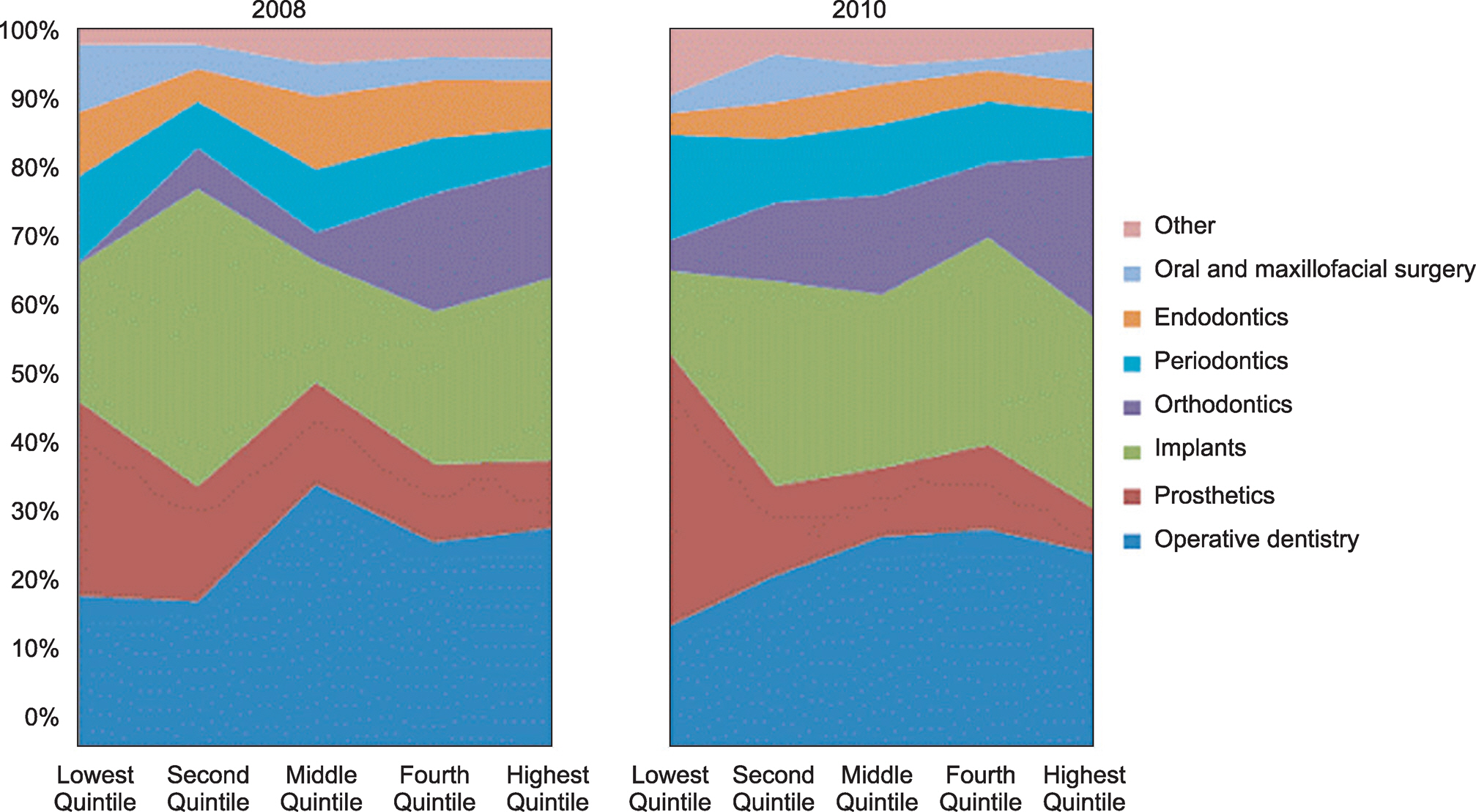J Korean Acad Oral Health.
2014 Mar;38(1):17-24.
Trends of household income and dental care spending
- Affiliations
-
- 1Apple Tree Dental Hospital, Ilsan, Korea.
- 2Department of Humanity and Social Dentistry, Wonkwang University College of Dentistry, Iksan, Korea. shinhosung@gmail.com
Abstract
OBJECTIVES
This empirical study aimed to identify the differences in expenditures by household income level, as well as the patterns of dental care spending by dental services.
METHODS
We analyzed the Korea Health Panel's data collected between 2008 and 2010. We calculated expenditures by service items by itemizing dental care services such as conservative, prosthetic, orthodontic, periodontal, surgical, preventive, dental implant care. Then we obtained the ratios of spending per item and per visit to overall out-of-pocket spending on dental care and used these as the weights for dental care cost allocation. Income quintiles were derived using the equivalence scale. Kakwani's concentration index was used to determine the degree of disparity by income quintile, and 95% confidence intervals were computed.
RESULTS
Out-of-pocket expenditures on dental care steadily increased over time and income quintile. The analysis of dental care spending by income quintile revealed that the level of expenditure of the first income quintile was 3.6 times lower than that of the fifth income quintile. In terms of expenditure comparison between 2008 and 2010, the first quintile households showed an increased spending on prosthetic and periodontal treatments, whereas the fifth quintile households spent a relatively high proportion on orthodontic and dental implant care. The concentration index revealed that conservative services and root canal treatments was significant and positive, indicating that the demand for, and utilization of, these services increase as household income increases. In contrast, prosthetic services showed a significant negative trend, indicating that these services are not as common among those with higher incomes.
CONCLUSIONS
To address the problems associated with the disparity in dental care expenditures based on income levels, it is necessary to establish policies that expand health insurance coverage and provide other supportive measures for low-income populations.
MeSH Terms
Figure
Reference
-
References
1. Heo SI. Change in the financial burden of health expenditures by income level. Health-welfare Policy Forum. 2009; 5:48–62.2. Song EC, Shin YJ. The effect of catastrophic health expediture on the transition to poverty and the persistence of poverty in South Korea. J Prev Med Public Health. 2010; 43:423–435.3. Park MJ, Choi YS, Tae YH, Choi JH, Baek SJ, Lee HY. Survey on the benefit coverage rate of National Health Insurance. Seoul: Health insurance policy institute;2011. p. 61–83.4. Millar WJ, Locker D. Dental insurance and use of dental service. Health Rep. 1999; 11:55–67.5. Quiñonez C, Grootendorst P. Equity in dental care among Canadian households. Int J Equity Health. 2011; 10:1–14.
Article6. Yeo JY, Jeong HS. Determinants of dental screening and unmet dental needs: interaction effect between geographical accessibility and economic affordability. Korean J Health Econ Policy. 2012; 18:109–126.7. Kim HS, Kim MK, Shin HS. Expenditure in ambulatory dental care and factors related to its spending. Korean J Health Policy Adm. 2012; 22:207–224.
Article8. Statistics Korea. Survey of Household Finances. Dae Jeon: Statistics Korea;2012. p. 26–39.9. Jeong YH. A report on the Korea health panel survey: health care utilizations and out-of-pocket spending. Health-welfare Policy Forum. 2011; 179:64–81.10. Kim DJ. Measurement of horizontal inequity in health care utilization using Korea health panal data. Health-welfare Policy Forum. 2012; 183:76–89.11. Seo NG, Hwang YH, Kang TW, Ahn SJ, Beak SC, Lee DH. Total health expenditure long and medium term prospects. Seoul: National health insurance service;2012. p. 80–95.12. Seo NK, Ahn SG, Hwang YH, Jeong YH, KO SJ. A report on the Korea health panel survey of 2010 II. Seoul: National health insurance service;2012. p. 41–42.13. Kakwani N, Wagstaff A, Doorslaer E. Socioeconomic inequalities in health: measurement, computation, and statistical inference. J Econom. 1997; 77:87–103.
Article14. Jung HS. Korean national health accounts and total health expenditure in 2011. Seoul: Ministry of health and welfare, Yonsei institute of health and welfare;2011. p. 109–124.15. OECD. Health at a glance 2011. Organization for Economic Cooperation and Development;2011.16. Shin HS, Kim HD. Income related inequality of dental care utilization in Korea. Korea Institute for Health and Social Affairs policy report. 2006; 26:63–93.17. Yoon YJ. Trend of horizontal equity in health care utilization and incidence of household catastrophic health expenditure [master’s thesis]. Seoul: Seoul National University;2012. [Korean].
- Full Text Links
- Actions
-
Cited
- CITED
-
- Close
- Share
- Similar articles
-
- Analysis of the trends in the disparities of toothbrushing and dental care use by household income level using the data from the Korea National Health and Nutrition Examination Survey
- A study on trends of dental caries disparities according to household income level of children and adolescents using data from the Korea National Health and Nutrition Examination Survey
- Catastrophic Health Expenditure Status and Trend of Korea in 2015
- Catastrophic Health Expenditure and Trend of South Korea in 2020
- The association between COVID-19 and changes in food consumption in Korea: analyzing the microdata of household income and expenditure from Statistics Korea 2019–2022


